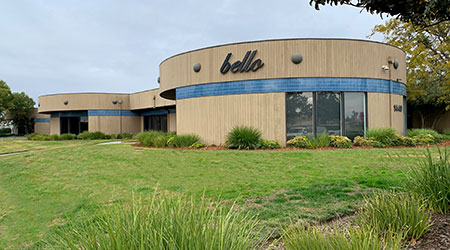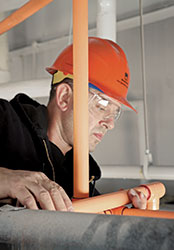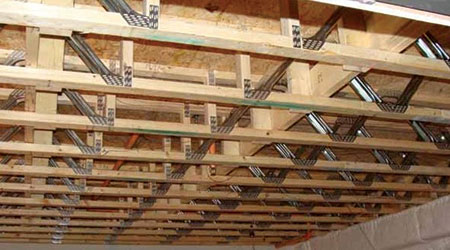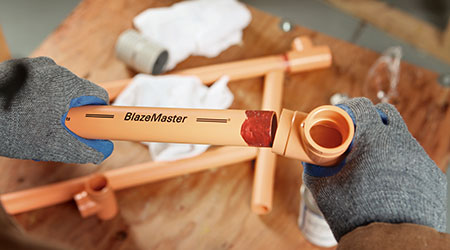SPONSORED
BlazeMaster® Fire Protection Systems - Branded Feature
CPVC Saves Money, Ensures Reliability for Fire Protection Systems
Material selection is a first priority when planning a fire protection system, whether in new construction or a
retrofit. Facility managers have two options for pipe and fittings: steel or CPVC.
While steel remains a popular choice, CPVC pipe offers significant advantages for commercial projects as well as
residential applications. CPVC pipe is lightweight, easily fabricated, flexible and resistant to corrosion. CPVC
has a Limiting Oxygen Index (LOI) of 60; since air contains only 21 percent oxygen, CPVC is self-extinguishing and
will not burn unless a flame is applied.

Reduced Costs for a Commercial Retrofit
Those advantages made CPVC pipe the perfect solution for retrofitting a 24,000-square-foot commercial office
building complex in Sacramento, California. The complex includes three light-hazard occupancy buildings connected
by combustible breezeways that needed to be sprinklered. The 50-year-old structures had never had sprinklers
installed, and local government was requiring them.
After retrofitting the first building using steel piping, Alwest Fire Protection, the fire sprinkler contractor on
the job, soon realized that CPVC pipe would be more cost-effective for the remaining two buildings. Alwest
President Bill Norwood chose BlazeMaster CPVC based on its long track record of proven performance, its excellent
customer support and its comprehensive chemical compatibility program.
The remaining two office buildings, totaling 16,000 square feet, required the installation of 240 sprinkler heads
in combustible concealed spaces. By using CPVC pipe, Alwest reduced its labor by about 35 percent, said Bill
Norwood, President of Alwest. He estimates that using CPVC instead of steel saved about 100 man-hours over the two
buildings.
Overall, use of CPVC pipe saved the building owner $21,000, primarily because CPVC pipe was much easier to
install. “Switching to CPVC pipe after completing the first building with steel was a smart move for Alwest – and
the building owner,” Norwood said.
Easy Installation

CPVC reduces installation costs for a variety of reasons. For starters, steel is heavy. It requires special
equipment to move around a job site and often two or more installers working in the same area. Its rigidity makes
it difficult to maneuver through tight spaces and install in hard-to-reach areas. It also requires torches and
loud threading machines to fabricate and join the system, which means costly hot-work permits, prefabrication, and
vacating occupants from the premises.
By comparison, CPVC piping systems weigh less, are flexible, and are joined together using a quick, one-step
solvent cement process. This reduces labor costs since one contractor can install an entire area by
himself/herself and fabrication can easily be completed on the spot.
CPVC installation is also cleaner and quieter, which creates minimal disruption for building occupants. At the
Sacramento retrofit, the work was done overnight, and crews needed to ensure the job site was cleaned up so a
doctor’s office in the building could start seeing patients in the morning.
“With steel, there would have been much more cleanup required and equipment to relocate before the crews ended
work for the night,” Norwood said.
Reduced Maintenance Costs
The $21,000 in cost savings Alwest created for the building owner by choosing CPVC will grow over time because
CPVC doesn’t corrode. Often with steel pipe, corrosion eats away at the interior of a pipe creating pinhole leaks.
Once corrosion starts in a steel system, “You repair it until it can’t be repaired anymore, then you have to
replace it,” Norwood said.
Steel pipes are also prone to scaling, which happens when dissolved minerals drop out of the water and attach to
the pipe wall, often near fittings and corners. As this scaling builds up, it can limit or even prevent the flow
of water entirely.
By comparison, CPVC pipe resists corrosion and scaling for the life of the system, even in salt air environments
or with fluctuating water pH balances. CPVC is also naturally immune to microbiologically influenced corrosion
(MIC). BlazeMaster CPVC is designed for a 50-year service life.

More Reliable Hydraulic Performance
By eliminating corrosion and scaling, CPVC pipe also delivers reliable hydraulic performance to ensure enough
water reaches a fire. A pipe’s surface has a direct impact on this—the rougher the surface, the more energy is
needed to pump the water through the system. With steel pipe, corrosion creates more friction along the surface.
The more friction, the slower the water flows in the event of an emergency.
The Hazen Williams formula was developed to help calculate this by measuring the friction and roughness along a
pipe material’s surface. For instance, BlazeMaster CPVC has a Hazen-Williams C-Factor of 150 and retains this
rating throughout its life. Conversely, new steel pipe starts with a C-Factor of 120, which dropped by over 50
percent for pipes that were in service for between 4 and 40 years. Over a relatively short period, steel pipe’s
surface deterioration limits the fire protection system’s hydraulic performance as compared to CPVC.
Additionally, the long-term smoothness of CPVC pipe can often mean smaller pipe sizes are required for the same
level of flow security in a fire protection system. This can result directly in builders and homeowners saving on
installation costs.
The CPVC Advantage
Based on his experience with the Sacramento office project, Norwood said he is enthusiastic about using CPVC pipe
for future commercial projects. He is hopeful that the success of this project will encourage other sprinkler
contractors and building owners to consider the use of CPVC pipe in nonresidential settings.
“Using CPVC pipe was not top of mind for me prior to this project, but now I’ll always consider it for future
commercial retrofits as well as residential applications,” he said. “The ease of installation gives CPVC pipe a
clear advantage over steel in many situations.”
For more information, please visit BlazeMaster.com.











